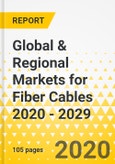This report provides information on market opportunities for fiber cable going into 5G networks (WDM, PON, Carrier Internet and SDM protocols). Addressable market forecasts (monetary data in US$ & cable lengths in kfm) are for each year from 2020 to 2029. Plans for fiber deployment are outlined and profiles of eleven fiber cable manufacturers are provided (from CommScope to YOFC).
This 5-section report also includes information on 5G frequency allocations, bandwidths and bitrates as well as infrastructure requirements. Methodology is described, global data is provided in the forms of data tables and column charts and analyses of these data are presented.
Geographic regions covered include Asia Pacific, Europe, North America and the “rest of the world” (RoW).
Major service providers in China, Europe (France, Italy, Spain, UK), Japan, South Korea and the USA are profiled.
This report includes updates to reflect the effects of the COVID-19 pandemic on the market.
Table of Contents
Executive Summary
The objectives of this five-section report are to identify the business opportunities for the fiber-optic cable market in fronthaul and backhaul for 5G. The goal is also to quantify these opportunities in both monetary value (TAM) terms and cable deployment lengths in nine-year forecasts.
This report is focused exclusively on the optical-fiber cable itself. Global and regional information is provided. The prospects for alternatives to fiber optics in the 5G infrastructure are considered, i.e. microwave and millimeter and radio and also free space optics.
At the core of this report are nine-year forecasts for the fiber-optic cable market. We have also analyzed the product/market plans of leading actors in this space and have examined appropriate strategies for optical networking (and other) players to better penetrate the 5G fronthaul and backhaul market.
Market data is segmented by the important protocols: WDM, PON (and NG PON), Carrier Ethernet and SDM. The meanings of the acronyms WDM, PON and SDM are described in this report.
The methodology used during the compilation of this report is similar to that used in other reports by the publisher. Both secondary and primary sources were used to compile this report and details are provided within its body. In this report the term “densify” applies to the 5G networks. It is not to be confused with the Canadian software company known as “Densify”.
Total addressable markets (TAMs) are provided (in US$, generally abbreviated ‘$’) for each year within the time span 2020-2029. Sales volumes are also reported on in detail i.e. as millions of fiber-km (fkm). From these data it can be seen that the fiber cabling alone needed to support 5G represents a huge market opportunity. For all the remaining market data we have segmented the markets by geographic region as follows: N. America (Canada and the USA), Europe (all European regional countries), Asia Pacific and “RoW” (rest of the world).
The Asia Pacific region is forecasted to dominate the consumption throughout the forecast period. Across Asia Pacific, in countries such as China, India, Japan and South Korea, governments are investing considerably in expanding 5G technology, which relies heavily on fiber-optic cables. China’s $32 billion vision to make the country “wired for 5G technology” has created more demand for optical fiber cable in the Asian region.
In the US it is regarded as imperative for wireless carriers to improve their 5G network infrastructures.
For instance, Verizon Communications Inc. agreed to purchase optical fiber from Corning, Inc. at a value exceeding $1.0bn. Corning agreed to sell up to 12.4 million miles of optical fiber to Verizon each year from 2018 through 2020, with a minimum purchase commitment of $1.05 billion. It is understood that at least 8 million miles of cable have now been installed under this agreement.
Of course any agreement like this can place a cap on future sales, rather than serve to engender sales.
The strong trends from traditional technologies regarding mobile fronthaul technology enable companies to reduce the deployment and maintenance cost of a 5G network. The increasing adoption of WDM-based fiber fronthaul is driven by the Common Public Radio Interface (CPRI’s) intensive consumption of optical fiber resources, combined with the lower reliability and lack of supervisory measures for managing fibers. Next-generation PON is suited to 5G fronthaul applications and is now attracting widespread industry attention.
The additional capacity and speed provided by 5G networks results in increasing stress on mobile backhaul networks. 5G backhaul depends on densification of the network, for example the number of small/macro cells within a given geographical area. Major initiatives in the emerging economies are expected to increase investments in mobile backhaul solutions because there is a very strong demand for managing old infrastructure and assets.
Within this report we provide information on Communications Service Providers (CSPs) as well as some basic information concerning the suppliers of fiber-optic 5G equipment. Each CSP was selected on the basis they have already installed fiber optics in their backhaul/fronthaul 5G networks – or else plan (or are expected) to make this move within the time-scale of this report: 2020 – 2029.
The total number of CSPs we have selected in this manner is 18, as follows:
AT&T, British Telecom (with a subsidiary known as EE), Charter Communications, China Mobile, China Telecom Corporation Ltd., China Unicom, KDDI Corporation, KT Corporation, LG Uplus, NTT DoCoMo, Orange, SK Telecom, SoftBank, Telefónica (owns O2), Three UK, T-Mobile USA, Inc., Verizon – and Vodafone.
The following 11 fiber cable manufacturers are profiled:
CommScope, Corning, Fujikura, Furukawa (including OFS), Nexans, Prysmian Group, Sterlite Technologies, Sumitomo Electric Lightwave, Taihan Fiber Optics, TRAXyL, - and Yangtze Optical Fibre and Cable Joint Stock Limited Company (YOFC).
Companies Mentioned
- Commscope
- Corning
- FiberHome
- Fujikura
- Sumitomo Electric
- Taihan
- YOFC








